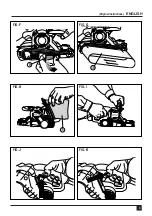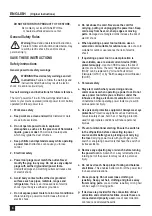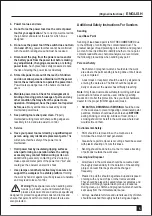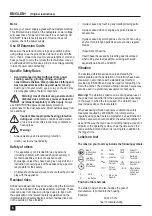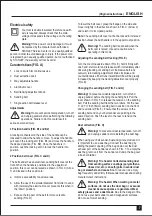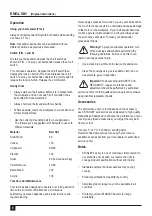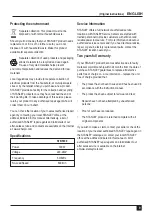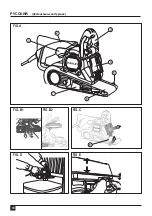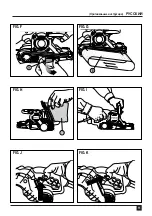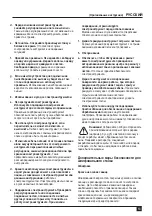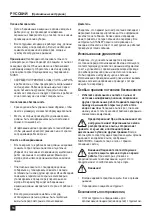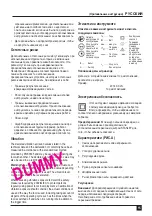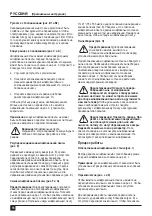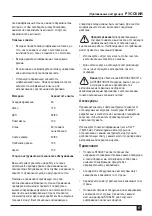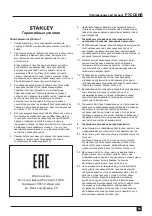
4. Power tool use and care
a. Do not force the power tool. Use the correct power
tool for your application.
The correct power tool will do
the job better and safer at the rate for which it was
designed.
b. Do not use the power tool if the switch does not turn
it on and off.
Any power tool that cannot be controlled
with the switch is dangerous and must be repaired.
c. Disconnect the plug from the power source and/or
the battery pack from the power tool before making
any adjustments, changing accessories, or storing
power tools.
Such preventive safety measures reduce
the risk of starting the power tool accidentally.
d. Store idle power tools out of the reach of children
and do not allow persons unfamiliar with the power
tool or these instructions to operate the power tool.
Power tools are dangerous in the hands of untrained
users.
e. Maintain power tools. Check for misalignment or
binding of moving parts, breakage of parts and any
other condition that may affect the power tools
operation. If damaged, have the power tool repaired
before use.
Many accidents are caused by poorly
maintained power tools.
f. Keep cutting tools sharp and clean.
Properly
maintained cutting tools with sharp cutting edges are
less likely to bind and are easier to control.
5. Service
a. Have your power tool serviced by a qualified repair
person using only identical replacement parts.
This
will ensure that the safety of the power tool is
maintained.
• Hold power tool by insulated gripping surfaces
when performing an operation where the cutting
accessory may contact hidden wiring or its own
cord.
Cutting accessory contacting a "live" wire may
make exposed metal parts of the power tool "live" and
could give the operator an electric shock.
• Use clamps or another practical way to secure and
support the workpiece to a stable platform.
Holding
the work by hand or against your body leaves it unstable
and may lead to loss of control.
Warning!
Take special care when sanding some
woods (e.g. beech, oak) and metal which may
produce toxic dust. Wear a dust mask specifically
designed for protection against toxic dust and fumes and
ensure that persons within or entering the work area are
also protected.
Additional Safety Instructions For Sanders
Sanding
Lead Base Paint
Sanding of lead based paint is NOT RECOMMENDED due
to the difficulty of controlling the contaminated dust. The
greatest danger of lead poisoning is to children and pregnant
women. Since it is difficult to identify whether or not a paint
contains lead without a chemical analysis, we recommend
the following precautions when sanding any paint:
Personal Safety
• No children or pregnant women should enter the work
area where the paint sanding is being done until all clean
up is completed.
• A dust mask or respirator should be worn by all persons
entering the work area. The filter should be replaced
daily or whenever the wearer has difficulty breathing.
Note:
Only those dust masks suitable for working with lead
paint dust and fumes should be used. Ordinary painting
masks do not offer this protection. See your local hardware
dealer for the proper (NIOSH approved) mask.
• NO EATING, DRINKING or SMOKING
should be done
in the work area to prevent ingesting contaminated paint
particles. Workers should wash and clean up
BEFORE
eating, drinking or smoking. Articles of food, drink, or
smoking should not be left in the work area where dust
would settle on them.
Environmental Safety
• Paint should be removed in such a manner as to
minimize the amount of dust generated.
• Areas where paint removal is occurring should be sealed
with plastic sheeting of 4 mils thickness.
• Sanding should be done in a manner to reduce tracking
of paint dust outside the work area.
Cleaning And Disposal
• All surfaces in the work area should be vacuumed and
thoroughly cleaned daily for the duration of the sanding
project. Vacuum filter bags should be changed
frequently.
• Plastic drop cloths should be gathered up and disposed
of along with any dust chips or other removal debris.
They should be placed in sealed refuse receptacles and
disposed of through regular trash pick-up procedures.
During clean up, children and pregnant women should be
kept away from the immediate work area.
• All toys, washable furniture and utensils used by children
should be washed thoroughly before being used again.
5
(Original instructions)
ENGLISH
Summary of Contents for STBS720
Page 2: ...2 FIG A FIG B1 FIG B2 FIG C FIG E FIG D 1 2 3 4 6 8 5 7 ENGLISH Original instructions...
Page 3: ...3 FIG F FIG H FIG J FIG G FIG I FIG K 9 10 11 Original instructions ENGLISH...
Page 10: ...10 FIG A FIG B1 FIG B2 FIG C FIG E FIG D 1 2 3 4 6 8 5 7...
Page 11: ...11 FIG F FIG H FIG J FIG G FIG I FIG K 9 10 11...
Page 12: ...12 STANLEY 1 b 2 b d f RCD GFCI ELCB 3 a b...
Page 13: ...13 d f g 4 a b c d c f 5...
Page 14: ...14 NIOSH 4 STANLEY NIOSH OSHA...
Page 16: ...16 3 B1 B2 1 2 2 C D C 1 a b c D C 2 E E E F G 5 3 21 76 533 6 H 7 I I J J K...
Page 17: ...17 80 150 60 80 100 80 40 60 100 100 2 STANLEY 3 21 76 533 STANLEY STANLEY...
Page 20: ...20 FIG A FIG B1 FIG B2 FIG C FIG E FIG D 1 2 3 4 6 8 5 7...
Page 21: ...21 FIG F FIG H FIG J FIG G FIG I FIG K 9 10 11...
Page 22: ...22 STANLEY 1 b 2 b d f RCD GFCI ELCB 3 a b...
Page 23: ...23 d f g 4 a b c d f g 5...
Page 24: ...24 NIOSH 4 STANLEY NIOSH OSHA...
Page 26: ...26 C 1 a b c D C 2 G 5 3 21 76 533 6 H 7 I I J J K...
Page 30: ...30 FRAN AIS Instructions initiales FIG A FIG B1 FIG B2 FIG C FIG E FIG D 1 2 3 4 6 8 5 7...
Page 31: ...31 Instructions initiales FRAN AIS FIG F FIG H FIG J FIG G FIG I FIG K 9 10 11...
Page 38: ...38 PORTUGUESE Instru es Originais FIG A FIG B1 FIG B2 FIG C FIG E FIG D 1 2 3 4 6 8 5 7...
Page 39: ...39 Instru es Originais PORTUGUESE FIG F FIG H FIG J FIG G FIG I FIG K 9 10 11...
Page 53: ...53 ARABIC FIG F FIG H FIG J FIG G FIG I FIG K 9 10 11...
Page 54: ...54 ARABIC FIG A FIG B1 FIG B2 FIG C FIG E FIG D 1 2 3 4 6 8 5 7...
Page 55: ...90618261 01 2015...



